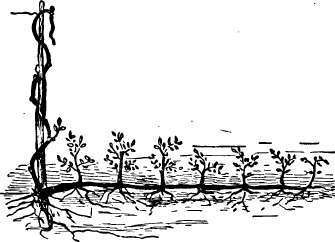53. Spring Layering
Description
This section is from the "American Horticultural Manual Vol1" book, by J. L. Budd. Also available from Amazon American Horticultural Manual, Part One (1902).
53. Spring Layering
In spring layering a whole cane of grape or limb of a shrub is laid down in a trench as shown in Fig. 20. After pegging down in the trench the limb or vine is left exposed to the air until the buds at the nodes start an upward growth of three or four inches. The shoots are then banked up gently and as growth advances the whole trench is filled. The rooting is from the base of the new shoots as noted in mounding (51. Rooting Sprouts by Mounding). In the fall after the leaves drop, the layered shoots are cut apart half way between the sets of growth. In spring layering of single shoots and twigs the operation is usually delayed until the bark will peel. A ring of bark is then taken off at the point to be covered in pots or in the earth. This favors more rapid rooting, as the process of healing begins at once. But as a rule such plants as the grape, climbing honeysuckle, tecoma, and passiflora put down in

Fig. 20. - Spring layering of the grape.
spring will root without ringing or twisting. In spring layering of branches of the rose, spiraea Van Houtteii, and other shrubs, where the twigs were twisted before laying down, it is found in autumn that many have not rooted, but have formed a large callus. If such shoots are made into callused cuttings and buried over winter they will grow readily as cuttings the next spring. This is also true of twisted summer layers that fail to root.
In summer layering of the climbing roses and shrubs the ones that callus and fail to emit roots will also grow as cuttings if buried and planted the next spring.
Continue to:


